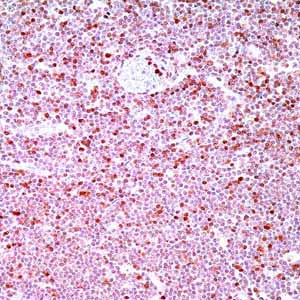
ZAP-70 (2F3.2)

Zeta-associated protein-70 (ZAP-70), a member of the Syk family of tyrosine kinases, has an important role in T-cell receptor signaling, natural killer cell activation, and early B-cell development.1 ZAP-70 protein is not expressed in most normal mature B-cells, but is expressed in various B- and T-cell lymphomas.1 Attempts to implement ZAP-70 analysis in clinical flow cytometry laboratories have been fraught with difficulty; this approach is technically challenging and results often have been unreliable. Detection of ZAP-70 protein by immunohistochemistry using tissue sections of chronic lymphocytic leukemia/small lymphocyctic lymphoma (CLL/SLL) is an easy and inexpensive technique.1 The clinical course of CLL/SLL is extremely variable: in some patients it is aggressive and requires chemotherapy within a relatively short time of diagnosis; in others it is indolent and asymptomatic and may not require treatment for many years2. It has recently been demonstrated that the mutational status of the immunoglobulin heavy-chain variable-region (IgVH) genes identifies 2 distinct groups of CLL/SLL: the patients with unmutated IgVH have an unfavorable clinical course, whereas those with mutated IgVH experience a favorable course. The reasons for the differences in the clinical course of CLL patients with mutated and unmutated IgVH genes are not clear. ZAP-70 expression is the best discriminator of mutated and unmutated IgVH genes3, ZAP-70 positive (>20% tumor cells) being Ig-unmutated and ZAP-70 negative being Ig-mutated. Wiestner et al.3 demonstrated that ZAP-70 expression levels assessed by means of Western blotting, real-time RT-PCR and immunohistochemistry are closely correlated with IgVH mutational status.
